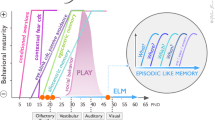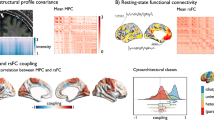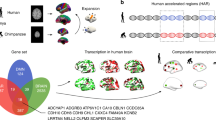Abstract
A large body of evidence has recently defined a field theory known as ‘evolutionary mismatch’, which derives its attributes largely from the fact that current environmental conditions are completely different from those in which the human central nervous system evolved. Current views on the evolutionary mismatch theory lack, however, any attempts to define which brain areas or neuronal circuits should be mostly involved in coding such misevolved traits and to what extent our neurobiological knowledge can be applied to the topographical localization of a specific psychopathology. In this respect the mesocorticolimbic dopaminergic circuits have long been misconceptualized as simple reward or reinforcement systems. Instead, they motivate and coordinate the functions of the higher brain areas that mediate planning and foresight and direct finalized movement in both animals and humans. These systems make animals intensely interested in exploring the world around them, but by the same means they also make them susceptible to the environmental stimuli that have been sought and consumed. It is has been speculated that the cortical dopamine targets that developed most recently in phylogeny are of particular functional value, and that the mesocorticolimbic dopaminergic system is involved in more complex integrative functions than previously assumed. In the present paper I will argue that some mental disorders may have their deep roots in the evolutionary mismatch between the normal physiology of the mesocorticolimbic dopaminergic system and the current environmental conditions in affluent societies.
This is a preview of subscription content, access via your institution
Access options
Subscribe to this journal
Receive 12 print issues and online access
$259.00 per year
only $21.58 per issue
Buy this article
- Purchase on Springer Link
- Instant access to full article PDF
Prices may be subject to local taxes which are calculated during checkout
Similar content being viewed by others
References
Divac I . Monotremunculi and brain evolution Trends Neurosci 1995; 18: 2–4
Wilson DR . Evolutionary epidemiology. Darwinian theory in the service of medicine and psychiatry Acta Biotheoretica 1993; 41: 205–218
Commentary on Greenfield PM, Language tools and brain: the ontogeny and phylogeny of hierarchically organized sequential behavior Behav Brain Sci 1994; 17: 357–365
Povinelli DJ, Preuss TM . Theory of mind: evolutionary history of a cognitive specialization Trends Neurosci 1995; 18: 418–424
Wise RA . The brain and reward. In: Liebman J, Cooper SJ (eds) The Neuro-pharmacological Basis of Reward Oxford University Press: Oxford 1989; 248–262
MacLean PD . Brain evolution relating to family, play and the separation call Arch Gen Psychiatry 1985; 42: 405–417
Le Moal M, Simon H . Mesocorticolimbic dopaminergic network: functional and regulatory roles Physiol Rev 1991; 71: 155–234
Panksepp J . Affective Neuroscience: the Foundations of Human and Animal Emotions Oxford Univ Press 1998; pp53–55
Bertler A, Rosengren E . Occurrence and distribution of catecholamine in brain Acta Physiol Scand 1959; 47: 350–361
Sano I, Gamo T, Kakimoto Y, Taniguchi K, Takesada M, Nishinuma K . Distribution of catechol compounds in human brain Biochem Biophys Acta 1959; 32: 586–588
Berger B . Dopaminergic innervation of the frontal cerebral cortex. Evolutionary trends and functional implications. In: Chauvel P, Delgado-Escueta (eds) Advances in Neurology Vol 57: Raven Press: New York 1992; pp525–544
Berger B, Gaspar P, Verney C . Dopaminergic innervation of the cerebral cortex: unexpected differences between rodents and primates [erratum appears in TINS 1991; 14: 119] TINS 1991; 14: 21–27
Pani AK, Anctil M . Evidence for biosynthesis and catabolism of monoamines in the sea pansy Renilla koellikeri (Cnidaria) Neurochem Int 1994; 25: 465–474
Palladini G, Ruggeri S, Stocchi F, De Pandis MF, Venturini G, Margotta V . A pharmacological study of cocaine activity in planaria Comp Biochem Physiol C Pharmacol Toxicol Endocrinol 1996; 115: 41–45
Lett BT, Grant VL . The hedonic effects of amphetamine and pentobarbital in goldfish Pharmacol Biochem Behav 1989; 32: 355–356
Vincent JD, Cardinaud B, Vernier P . Evolution of monoamine receptors and the origin of motivational and emotional systems in vertebrates Bull Acad Natl Med 1998; 182: 1505–1516
Walker RJ, Brooks HL, Holden-Dye L . Evolution and overview of classical transmitter molecules and their receptors Parasitology 1996; 113: S3–S33
Cardinaud B, Sugamori KS, Coudouel S, Vincent JD, Niznik HB, Vernier P . Early emergence of three dopamine D1 receptor subtypes in vertebrates. Molecular phylogenetic, pharmacological, and functional criteria defining D1A, D1B, and D1C receptors in European eel Anguilla anguilla J Biol Chem 1997; 272: 2778–2787
Fryxell KJ . The evolutionary divergence of neurotransmitter receptors and second-messenger pathways J Mol Evol 1995; 41: 85–97
Camps M, Kelly PH, Palacios JM . Autoradiographic localization of dopamine D1 and D2 receptors in the brain of several mammalian species J Neural Transm Gen Sect 1990; 80: 105–127
Nesse RM, Williams GC . Why We Get Sick Random House: New York 1994
McGuire MT, Troisi A . Darwinian Psychiatry Oxford University Press: New York 1998
Ahn S, Phillips AG . Dopaminergic correlates of sensory-specific satiety in the medial prefrontal cortex and nucleus accumbens of the rat J Neurosci 1999; 19: RC29
Fiorino DF, Coury A, Phillips AG . Dynamic changes in nucleus accumbens dopamine efflux during the Coolidge effect in male rats J Neurosci 1997; 17: 4849–4855
Fibiger HC . Role of catecholamine transmitters in reward systems: implications for the neurobiology of affect. In: Oreland E (ed) Brain Reward Systems and Abuse New York Press: New York 1987; 61–74
Cenci MA, Kalén P, Mandel RJ, Björklund A . Regional differences in the regulation of dopamine and noradrenaline release in medial frontal cortex, nucleus accumbens and caudate-putamen: a microdialysis study in the rat Brain Res 1992; 581: 217–228
Phillips AG, Atkinson LJ, Blackburn JR, Blaha CD . Increased extracellular dopamine in the nucleus accumbens of the rat elicited by a conditioned stimulus for food: an electrochemical study Can J Physiol Pharmacol 1993; 71: 387–393
Berridge KC, Robinson TE . What is the role of dopamine in reward: hedonic impact, reward learning, or incentive salience? Brain Res Rev 1998; 28: 309–369
Bassareo V, Di Chiara G . Differential influence of associative and nonassociative learning mechanisms on the responsiveness of prefrontal and accumbal dopamine transmission to food stimuli in rats fed ad libitum J Neurosci 1997; 17: 851–861
Blackburn JR, Pfaus JG, Phillips AG . Dopamine functions in appetitive and defensive behaviors Prog Neurobiol 1992; 39: 247–279
Rolls ET . The Brain and Emotions Oxford University Press: New York 1999
Jacobs GH, Neitz M, Deegan JF, Neitz J . Trichromatic colour vision in New World monkeys Nature 1996; 382: 156–158
Finlay BL, Darlington RB . Linked regularities in the development and evolution of mammalian brains Science 1995; 268: 1578–1584
Rolls ET, Rolls JH . Olfactory sensory-specific satiety in humans Physiol Behav 1997; 61: 461–473
Rolls ET, Baylis LL . Gustatory, olfactory, and visual convergence within the primate orbitofrontal cortex J Neurosci 1994; 14: 5437–5452
Gershon ES, Hamovit JH, Guroff JJ, Nurnberger JI . Birth-cohort changes in manic and depressive disorders in relatives of bipolar and schizoaffective patients Arch Gen Psychiatry 1987; 44: 314–319
Pincus HA, Tanielian TL, Marcus SC, Olfson M, Zarin DA, Thompson J et al. Prescribing trends in psychotropic medications: primary care, psychiatry, and other medical specialties JAMA 1998; 279: 526–531
Brown AS, Varma VK, Malhotra S, Jiloha RC, Conover SA, Susser ES . Course of acute affective disorders in a developing country setting J Nerv Ment Dis 1998; 186: 207–213
Nesse RM, Berridge KC . Psychoactive drugs in evolutionary perspective Science 1997; 278: 63–66
Selye H . The evolution of the stress concept Am Sci 1973; 61: 692–696
Akil HA, Morano IM . Stress. In: Kupfer D, Bloom F (eds) Psychopharmacology the Fourth Generation of Progress Raven Press: New York 1995; 773–785
Pani L, Porcella A, Gessa GL . The role of stress in the pathophysiology of the dopaminergic system Mol Psychiatry 2000; 5: 14–21
Kaneyuki H, Yokoo H, Tsuda A, Yoshida M, Mizuki Y, Yamada M et al. Psychological stress increases dopamine turnover selectively in mesoprefrontal dopamine neurons of rats: reversal by diazepam Brain Res 1991; 557: 154–161
Murphy BL, Arnsten AF, Goldman-Rakic PS, Roth RH . Increased dopamine turnover in the prefrontal cortex impairs spatial working memory performance in rats and monkeys Proc Natl Acad Sci USA 1996; 93: 1325–1329
Murphy BL, Arnsten AF, Jentsch JD, Roth RH . Dopamine and spatial working memory in rats and monkeys: pharmacological reversal of stress, induced impairment J Neurosci 1996; 16: 7768–7775
Steketee JD, Kalivas PW . Sensitization to psychostimulants and stress after injection of pertussis toxin into the A10 dopamine region J Pharmacol Exp Ther 1991; 259: 916–924
Sorg BA, Steketee JD . Mechanisms of cocaine-induced sensitization Prog Neuropsychopharmacol Biol Psychiatry 1992; 16: 1003–1012
Meiergerd SM, Schenk JO, Sorg BA . Repeated cocaine and stress increase dopamine clearance in the rat medial prefrontal cortex Brain Res 1997; 773: 203–207
Zahrt J, Taylor JR, Mathew RG, Arnsten AF . Supranormal stimulation of D1 dopamine receptors in the rodent prefrontal cortex impairs spatial working memory performance J Neurosci 1997; 17: 8528–8535
Deutch AY, Clark WA, Roth RH . Prefrontal cortical dopamine depletion enhances the responsiveness of mesolimbic dopamine neurons to stress Brain Res 1990; 521: 311–315
Friedhoff AJ, Carr KD, Uysal S, Schweitzer J . Repeated inescapable stress produces a neuroleptic-like effect on the conditioned avoidance response Neuropsychopharmacology 1995; 13: 129–138
Finlay JM, Zigmond MJ . The effect of stress on central dopaminergic neurons: possible clinical implications Neurochem Res 1997; 22: 1387–1394
Haber SN, Fudge JL . The interface between dopamine neurons and the amygdala: implications for schizophrenia Schizophr Bull 1997; 23: 471–482
Davis M . The role of the amygdala in conditioned fear. In: Aggleton JP (ed) The Amygdala: Neurobiological Aspects of Emotion, Memory, and Mental Dysfunction Wiley: New York 1992; 255–305
Gelowitz DL, Kokkinidis L . Enhanced amygdala kindling after electrical stimulation of the ventral tegmental area: implications for fear and anxiety J Neurosci 1999; 19: RC41
Bertolucci-D'Angio M, Serrano A, Scatton B . Mesocorticolimbic dopaminergic systems and emotional states J Neurosci Methods 1990; 34: 135–142
D'Angio M, Serrano A, Driscoll P, Scatton B . Stressful environmental stimuli increase extracellular DOPAC levels in the prefrontal cortex of hypoemotional (Roman high-avoidance) but not hyperemotional (Roman low-avoidance) rats. An in vivo voltammetric study Brain Res 1988; 451: 237–247
Louilot A, Taghzouti K, Simon H, Le Moal M . Limbic system, basal ganglia, and dopaminergic neurons. Executive and regulatory neurons and their role in the organization of behavior Brain Behav Evol 1989; 33: 157–161
Gendreau PL, Gariépy JL, Petitto JM, Lewis MH . D1 dopamine receptor mediation of social and nonsocial emotional reactivity in mice: effects of housing and strain difference in motor activity Behav Neurosci 1997; 111: 424–434
Cavazzuti E, Bertolini A, Vergoni AV, Arletti R, Poggioli R, Forgione A et al. l-Sulpiride, at a low, non-neuroleptic dose, prevents conditioned fear stress-induced freezing behavior in rats Psychopharmacology (Berl) 1999; 143: 20–23
Nader K, LeDoux J . The dopaminergic modulation of fear: quinpirole impairs the recall of emotional memories in rats Behav Neurosci 1999; 113: 152–165
Wehr TA, Giesen HA, Moul DE, Turner EH, Schwartz PJ . Suppression of men's responses to seasonal changes in day length by modern artificial lighting Am J Physiol 1995; 269: R173–R178
Wehr TA . Effect of seasonal changes in daylength on human neuroendocrine function Horm Res 1998; 49: 118–124
Gessa GL, Pani L, Fadda P, Fratta W . Sleep deprivation in the rat: an animal model of mania Eur Neuropsychopharmacol 1995; 5: S89–S93
Fadda P, Martellotta MC, Gessa GL, Fratta W . Dopamine and opioids interactions in sleep deprivation Prog Neuropsychopharmacol Biol Psychiatry 1993; 17: 269–278
Wright JB . Mania following sleep deprivation Br J Psychiatry 1993; 163: 679–680
Angst J . The emerging epidemiology of hypomania and bipolar II disorder J Affect Disord 1998; 50: 143–151
Chou JC, Zito JM, Vitrai J, Craig TJ, Allingham BH, Czobor P . Neuroleptics in acute mania: a pharmacoepidemiologic study Ann Pharmacother 1996; 30: 1396–1398
Changeux JP . L'Homme Neuronal Fayard: Paris 1983
Watanabe M . Reward expectancy in primate prefrontal neurons Nature 1996; 382: 629–632
Sirigu A, Zalla T, Pillon B, Grafman J, Agid Y, Dubois B . Selective impairments in managerial knowledge following pre-frontal cortex damage Cortex 1995; 31: 301–316
Damasio AR . The somatic marker hypothesis and the possible functions of the prefrontal cortex Philos Trans R Soc Lond B Biol Sci 1996; 351: 1413–1420
Anderson SW, Bechara A, Damasio H, Tranel D, Damasio AR . Impairment of social and moral behavior related to early damage in human prefrontal cortex Nat Neurosci 1999; 2: 1032–1037
von Zerssen D, Akiskal HS . Personality factors in affective disorders: historical developments and current issues with special reference to the concepts of temperament and character J Affect Disord 1998; 51: 1–5
Akiskal HS . Toward a definition of generalized anxiety disorder as an anxious temperament type Acta Psychiatr Scand Suppl 1998; 393: 66–73
Perugi G, Toni C, Akiskal HS . Anxious-bipolar comorbidity. Diagnostic and treatment challenges Psychiatr Clin North Am 1999; 22: 565–583
Acknowledgements
I am grateful to Anna Porcella for her critical comments and to David Webb for his precise editorial work on the manuscript. This work was supported by a CNR grant.
Author information
Authors and Affiliations
Corresponding author
Rights and permissions
About this article
Cite this article
Pani, L. Is there an evolutionary mismatch between the normal physiology of the human dopaminergic system and current environmental conditions in industrialized countries?. Mol Psychiatry 5, 467–475 (2000). https://doi.org/10.1038/sj.mp.4000759
Received:
Revised:
Accepted:
Published:
Issue Date:
DOI: https://doi.org/10.1038/sj.mp.4000759
Keywords
This article is cited by
-
Sensing Happiness in Senseless Information
Applied Research in Quality of Life (2021)
-
Evolutionary Mismatch, Emotional Homeostasis, and “Emotional Addiction”: A Unifying Model of Psychological Dysfunction
Evolutionary Psychological Science (2018)
-
Genes and attention deficit hyperactivity disorder
Current Psychiatry Reports (2001)



